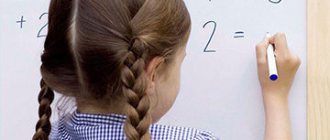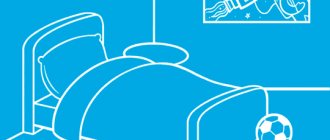One of the important processes of preparing for school is teaching not only writing, but also mathematical literacy. How to teach a child to write numbers?
How to organize a lesson in an interesting and playful way?
If written classes require a specific place, then oral mathematics lessons can be conducted anywhere - on vacation, in transport, on the way home.
Teaching methods
At the moment, the following methods exist:
- Mathematical copybooks (hatching, writing numbers and printed geometric shapes) - designed for joint work between teacher and student. They consist of separate, varied and fun lessons that, in a playful way, help you master writing the numbers from 0 to 9, starting with individual parts and ending with whole numbers. The copybooks differ in color and black and white, cell sizes (small and wide), as well as additional tasks and exercises for the development of logic, thinking, attention and explanations for adults.
- Dotted numbers are one of the most popular methods, allowing the student to quickly and effortlessly remember how to write a particular number. The essence of the training is that the adult is required to put dots or lines in the shape of a number, which the child will have to connect with each other.
- Counting sticks, matches, pencils and other elements are the best way to help kids add the outlines of numbers.
Equally important when teaching the basics of mathematics are number cubes, dominoes, puzzles and other learning materials.
Children's copybooks of numbers - learning to write numbers
The harmonious development of a child is of great importance for caring parents, so at an early age he should be taught to write letters and numbers beautifully.
As you know, many modern schools do not devote enough time to calligraphy, so you should definitely conduct independent additional classes at home. If you don’t have the skills of a professional teacher, it doesn’t matter, because right on our Childdevelop website you can find and download children’s copybooks of numbers, thanks to which learning will become not only useful, but also entertaining! There is an opinion that teaching a child to write is somewhat more difficult than teaching a child to read. Beautiful handwriting can be compared to true art, so it is very important that a child masters calligraphy at an early age.
By visiting our website, you can print out the numbers for free and easily use them in practical activities with your child. We bring to your attention the most interesting and varied collections, which present numbers for preschoolers. We are confident that they will immediately attract your child's attention and awaken his genuine interest in the learning process.
Preparation
The main thing when learning is meaningfulness.
- First, parents should conduct oral instruction before writing numbers. Graphic writing of numbers should not be something abstract. The child is required to be able to count to 10, as well as recognize this or that number in printed form.
- Secondly, the baby should be familiarized with the cage. For the first lesson, it is enough to draw a small cell on a landscape sheet and show its center, corners and sides, and also teach the preschooler to find the upper and lower boundaries, all sides of the cell and divide it into four equal parts.
- Thirdly, you should start learning directly after the child can independently draw all the individual elements of a number - sticks, ovals, semicircles and dashes.
Direction of writing numbers
The best age for starting to learn calligraphic writing is considered to be 5-6 years.
What copybooks should I use?
To teach a child to spell, it is very convenient to use printed material. Special copybooks can be printed out yourself or purchased from the office department. It is important to take into account that they come in several types and are designed for different ages.
At 3–4 years old, it is better to use coloring books with funny numbers. For example, these:
At 4–5 years old, the following recipes with figures are recommended for hand training:
It is also useful to print out the uppercase numbers from 1 to 10 and move your finger along them in the right direction:
For children 5–7 years old, it is recommended to use copybooks that contain an example of writing a number, its dotted outline that needs to be circled, as well as space for independent writing. It would be great if the recipes included additional exercises for training your hand and learning to count. An example of good copybooks for preschoolers:
What should a child be able to do?
The child should be familiar with tracing the contours of various shapes and lines, be able to color images and confidently hold pencils in their hands.
The student should easily trace the dotted line sticks and hooks.
The correct placement of the hand is also important. A preschooler should know how to accurately hold a pen and sit at a table.
A child who has perfectly developed fine motor skills can easily master writing lessons. Excellent trainers for fingers are modeling from plasticine, polymer clay, salt dough and drawing in an album (from ordinary scribbles to meaningful plot drawings).
Many young mothers begin to get bored while on maternity leave from a series of monotonous tasks. How not to go crazy while on maternity leave? Choose a hobby and develop yourself.
How to put your baby to sleep in 5 minutes? Read useful tips here.
You can see the options for crafts made from matchboxes at the link.
Teaching numbers in a playful way
The light, interesting and bright environment allows the baby to easily remember numbers from 0 to 9 and grasp new material on the fly. Success in learning will be more noticeable if the adult does not focus on the lesson itself, but presents the topic being studied in passing.
After the preschooler gets acquainted with a certain number, it should be drawn on a landscape sheet, preferably in an enlarged size. If desired, the number can be colored with a colored pencil. Further, joint fantasies of the child and the adult are welcomed.
Plasticine numbers
You can make a number from plasticine, roll out puff pastry or any other baking dough, cut out the required number from it and bake in the oven. The baby’s mother can be 100% sure that her son or daughter will not only eat the number she personally prepared with great pleasure, but will also remember the baked number for the rest of her life.
Multi-colored cubes, cards or circles with images of numbers are perfect for reviewing the material covered. The adult should be shown the required element, and the child should accurately guess the required number.
Cookies “Units”
Kids prefer “want” to the word “need,” so each new number should be perceived with enthusiasm. Otherwise, the baby will develop an aversion to learning, which will certainly lead to problems at school.
Copybooks for schoolchildren
Such copybooks are often requested at school in order to give the very basics that are so necessary for a child at the initial level of education. Many parents decide to purchase additional worksheets to help them improve their child’s skills at home. In any case, such copybooks provide all the necessary basic knowledge, which will become the foundation for teaching a child to read and write.
Recipes for 1st grade
Copybooks for first-graders can easily be called the main notebooks in elementary school. The child’s task is to learn to write beautifully and quickly. For a child, such a task seems insurmountably difficult. In the first grade educational program, very little time is devoted to copywriting.
The copybooks contain many pictures that make learning easier and help to divert the child’s attention, when necessary, from the difficult task of learning the elements of lowercase letters. Capital letters and words
Capital letters and words
Learning by association
Abstract numbers mean nothing to a child; for this reason, visual representations are the best way to help children remember certain numbers with ease. For example, a baby’s mother can compare the number 2 with the figure of a swan, 0 with the letter O or a circle, 8 with a matryoshka, etc.
There are several types of associative methods:
- The hanger method helps children remember certain numbers by assigning each number a visual image or a specific word (for example, 1 is an athlete, 5 is an image of a school, 15 is an athlete participating in school competitions).
- Comparing numbers with a specific image - 0 looks like a ball, a sun, a circle; 1 is a toothpick, straw, flashlight, etc.
- O'Brien's method - connecting numbers with the names of famous people. The main principle of the association is number – person – action. For example, 1 is Agnia Barto, 5 is a writer, and already the number 15 is a person who writes poetry.
- Rhymes are combinations of numbers with a certain consonance of words or rhymes.
The child should be taught one associative technique that seems most convenient and easy to remember for an adult. Otherwise, the student will get confused in a large number of difficult-to-understand techniques for memorizing images.
Learning numbers using time and calendar
This method is a type of associative method: each number becomes a kind of reminder for daily activities (for example, seven is wake-up time, nine is kindergarten, three is tea with cookies, five is a walk, etc.).
An excellent replacement for a watch is a calendar with a moving window. Any upcoming event is shown to the baby. The adult must allow the student to manage the calendar independently.
Counting calendar
Naturally, the more colorful the new learning material is, the better the numbers are remembered. Moreover, the numbers in the calendar allow you to teach kids how to count to 31 without much difficulty.
For a more interesting learning experience for adults, it is advisable to prepare a large, bright watch with a round dial and multi-colored numbers. Instead of a calendar, you can keep a diary, come up with a special book of notes or a schedule.
Copybooks
Mathematical copybooks are not just ready-made contours needed for tracing.
The purpose of training is to teach the baby to maintain the correct tilt.
That is, the number 1 should not be written with a vertical stick, but should be started from the middle of the cell, drawn with an inclined line to the upper right corner and smoothly lowered to the lower center.
Copybook assignments allow you to teach your child not only to write numbers correctly and strengthen counting skills from 0 to 9, but also to navigate checkered sheets, develop graphic skills, logical thinking and visual perception. Regular writing activities help improve hand coordination and fine motor skills.
Russian copybooks differ from American and other foreign textbooks, since the principles of writing ones, sevens and nines have some differences.
How to write numbers in brackets
In accounting, financial and legal documents, various kinds of statements, one has to deal with the need to write numbers in words in brackets to decipher the monetary amounts previously indicated in digital terms.
Why this is done is easy to guess from the standpoint of simple common sense. By duplicating a digital record with an alphabetic one, we reduce the likelihood of error and possible fraud. Words are harder to fake than numbers.
You also need to write the amount in words in brackets correctly:
- in the nominative case;
- with a capital letter;
- kopecks (cents, eurocents) are written in numbers in both cases.
For example: The total contract amount is RUB 1,326,787. 45 kopecks (One million three hundred twenty-six thousand seven hundred eighty-seven rubles. 45 kopecks.)
This writing option is also possible, when kopecks are written once, brackets are placed in front of them and only the amount in rubles (dollars, euros) is deciphered in them:
The total contract amount is RUB 1,326,787. (One million three hundred twenty-six thousand seven hundred eighty-seven rubles) 45 kopecks..
We figured out in which cases it is necessary to write numerals in words, and in which - in numbers. If you can’t remember this amount of background information right away, use this article as a reminder and write the numbers in words correctly.
By the way, on our website we have a special tool “Translating numbers into numbers in words“. If you need to quickly convert numbers into ready-made text (or sum), it is convenient to use.
Good for you!
Info center
Information and educational center of the project “Panda-copywriting”
- 3
Writing rules
The first numbers should be shown to the baby on a large sheet of paper. An adult needs to be patient and thoroughly explain to the student the various details of the numbers (straight and wavy lines, oval, semicircle) and the rules for writing them: where to start the line, in which direction to go, when to lift the pen from the sheet and where to end.
So:
- Number 1 – you need to start from the center of the cell, move smoothly to the upper right corner and lower it to the center of the cell.
- Number 2 – starts just below the middle of the center of the cell. The point is drawn in a line upward and then rounded in the upper right corner of the cell, drawn downward with a slant to the left and ends with a lower wavy line.
- Number 3 is two semi-oval lines. It needs to start from the middle of the cell, lead with a curve to the upper right corner, lower it down just above the middle of the cell and repeat the oval, leading to the lower left corner.
- Number 4 - starts from the middle of the top cell, runs a straight line down to the middle, continues to the right, but not to the end, and ends with a long stick, which starts from the upper right corner and ends in the middle of the cell.
- Number 5 - consists of three parts: a straight line from the upper middle of the cell to its center, a semicircle on the right side of the cell and the final upper wavy line, which is drawn from left to right.
- Number 6 is written in one continuous line; the pen should not be lifted from the sheet of paper. The number starts with a semi-oval from the upper right corner of the cell, draws a line to the bottom, rounds it into a circle at the bottom and ends just above the center of the cell.
- Number 7 - starts with a wavy line just to the left of the upper side of the cell, goes to the right and drops in a straight line to the middle of the lower side, which at the end must be crossed out with a long straight stick.
- The number 8 is drawn in an oval line from the middle of the left side of the cell, moves in a semicircle to the right side, touching its side, smoothly falls to the left and is again rounded into the middle of the cell, touching the starting point of the number.
- Number 9 – starts from the middle of the right side of the cell, goes up, smoothly rounds to the starting point, then the line with a bend descends to the lower part of the middle of the cell.
- Number 0 – represents an oval and starts from the middle of the right side of the cell, goes up, goes down and returns to the starting point.
At 3 years old, a child begins to try to do everything on his own, but he does not always succeed. Psychologists identify a crisis at the age of 3 in a child. At this moment, parents should be especially attentive to changes in the baby’s behavior.
We make crafts with a child from cereals - see product options on this page.
The child needs to be given time to master new material. You can diversify written lessons with playful moments, allow your child to “teach” his favorite bear on his own, play with toy numbers, etc.
The article introduces adults to the basic rules of writing numbers and popular teaching methods. Practical recommendations for working with preschoolers will help inexperienced parents independently teach their kids to write numbers correctly.
Selecting a copybook
A special copybook will help parents teach their young schoolchildren to write numbers correctly. It is necessary to approach its selection carefully, paying attention to how the necessary educational material is presented in it. It is desirable that it be organized as follows:
The numbers in bold black font come first - these are examples that the child should focus on. Behind the black numbers there should be two or three characters printed with dots or a very light shade of font. Children will write these numbers by circling the dots as they learn. Throughout one line there should be several numbers printed in bold, those that will serve as a model for the child (and not one or two just at the beginning of the line).
These requirements are met by the copybook “Calligraphy of numbers. Copybooks for mathematics." - these are copybooks of a new generation in accordance with the requirements of the Federal State Educational Standard of Education, which is an appendix to the mathematics course according to the L. G. Peterson program “Learning to Learn” for 1st grade.











